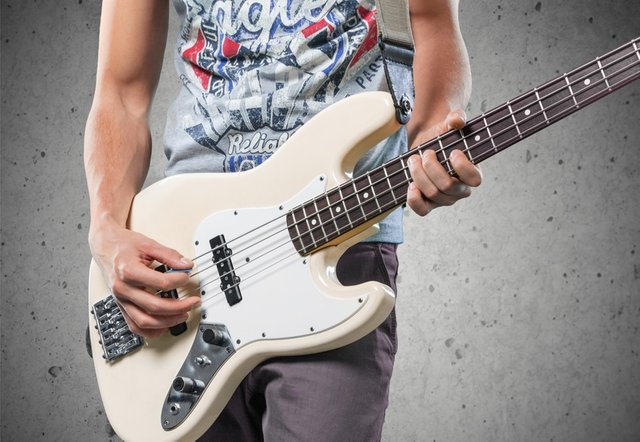LIFE HACK: How to Join A Rock Band in 4 Weeks Using Edtech
In this article, I’ll spill the beans on a rock music secret—the difference between a total beginner and bass guitarist in a rock band is about three months.
Bass guitar is an easy instrument to learn.
I think I should probably qualify that statement, before all the bass nuts on Twitter start hurling 140 characters of abuse at me. The bass is an easy instrument to learn if you stick with simple bass lines. Now, as luck would have it, rock music is full of famous songs with easy bass lines.
As you might know, I have an interest in Edtech. I was also a professional guitar tutor for several years and have been the frontman of several amateur rock bands. So, in a way, this article was inevitable.
I’m going to outline a four week plan, to transition you from beginner to band-ready.
During the process, we’re going to rely entirely on Edtech in the form of videos and apps. With that said, I’d also recommend taking lessons with an online or local tutor, to help you speed along.
Week One Part One: Getting the Basics Down
You need to know your way around the instrument and then learn how to tune it. For this, we’ll use two sources: YouTube and an app—because learning the same lesson from two different angles is a proven way to help it stick. We’ll start with the video: Learn Bass Lesson 01 - Introduction to the bass guitar, which gives you a good overview of the bass.
For tuning, we’ll use a free and popular tuning app along with another YouTube video. The App is GuitarTuna by Yousician, available on both iTunes and Google Play for free. The YouTube video is How to Tune Your Bass.
Week One Part Two: Music Emerges
Firstly we’ll revisit the same learning as in part one using the free app: Beginner Bass Method HD LITE (available on iTunes and Google Play), then spend the rest of the first week on their ‘Level 1’, which teaches you how to hold a pick, read tab and start playing music for real.
Bass Method HD LITE is an example of good, simple Edtech. It’s well planned and combines diagrams with video, allowing two means of learning. It also includes a feature where you can slow down the video to get a better look if you need to. Level 1 is free and includes all you need for the purpose of this guide. Of course, if you feel this app suits your learning style particularly well, you might want pay the small fee to access their full programme.
Week 2 and 3: Working on Your Set
During the next two weeks, you’re going to learn a ‘set’ of five rock songs.
Check out this list of 50 easy bass guitar rock songs and select five that get your toe tapping and your head bobbing. It’s worth saying that a genuine love of these five songs might be the difference between failure and success, so take a minute and select ones that really mean something to you.
Next it’s time to turn to our third and final app.
This one’s called Songsterr and it costs $4.99 USD per month. You can download it from either iTunes or Google Play. Songsterr has a database of 500,000 songs in tabs and chords format. The bank of songs include both six-string guitar and bass guitar. With this app, you will be able to learn your five rock songs using tab, charts and backing tracks. Pretty cool, don’t you think?
Wake up to the day's most important news.
Songsterr is a seriously good Edtech app and was even featured in the Wall Street Journal as one of “The Best Apps for Learning to Play Music”. It was also the Apple App of the Week. It’s very interactive and has several great features including backing music to practice to, tab that scrolls as you play and an option to slow the song by half.
For those of you who would like to complete this whole method without spending anything, it can certainly be done. All you need to do is search in Google for your five songs, including the words ‘bass guitar tab’ along with the title and artist. The down side is you won’t have scrolling tab or backing tracks to practice along with, unless you can find those elsewhere for free of course.
Whether you choose to use Songsterr, or go the free route, this is where the hard work needs to be put in. The next two weeks are make or break to our one-month plan. You should spend at least one hour (if not two) practising these bass lines every day. Conquer them one at a time and memorise them by repeating small sections.
At this stage, if you make a mistake, go back in the song to just before the part that contained the error and repeat the section until you’ve mastered it. Only when you’re playing the section error-free should you move on.
Week four part one: Preparing to Rock
You’ve come a long way in three weeks. You’re fingertips are sore but you’ve made it. You can now play five rock songs from start to finish. Of course, there are still mistakes, but that’s to be expected.
Now we’ll shift our focus towards band auditions and your first gig. The big difference between playing with a band and practising by yourself is that your band won’t stop when you make a mistake. You’re expected to recover quickly and get back in the groove before people notice.
So, this week you’re going to play each song, one after the other, all the way through. Instead of stopping when you make a mistake, learn how to get back on your feet after stumbling, by picking the song up again as soon as you can.
With that said, if one particular section of a song causes you problems every time, you should revert to the practice method of repeating the section and perfecting it before returning to this new way to practice.
Week four part two: Beyond the Bass
There are other skills that improve your chance of getting into a rock band. One is the ability to sing backing vocals. Now, singing is a whole topic in itself, but if you’re already a confident singer then all you need to do is read a little about mic technique and try singing some ‘oohs’ and ‘aahs’ while you practice your bass.
Another element is how well you get on with the existing band members. Obviously, a large chunk of that is just down to personality, but some of it will be down to the conversations you have with them about rock music and the music industry in general.
With that in mind, take some time to read up about the artists who made your five songs famous. Do a little research about the songs themselves. After that, learn about the music scene in your area including venues for gigs, small festivals and local radio stations.
Finally, there’s a little you should know about music tech. Find out on what gear you will need as a bass player when playing at small venues. If downloading and streaming music is all you’ve ever known, fill in the gaps in your knowledge of general music tech.
You’ve made it! It’s time to start replying to ads for bass players. I recommend being honest about the fact that you’re a beginner but to let them know you’re a quick learner (that’s an understatement). Some good places to look for bands are in Facebook groups for local musicians and on classified sites like Craigslist and Gumtree. There are also some dedicated sites for connecting musicians with bands, they can be a great option too.
All that’s left is to say... see you on stage.
———————————————————————
This article was originally posted on Oliver Braithwaite’s blog: Edtech & Co and also appeared on Huffpost and Life Hack. Oliver is the founder and CEO of Stars & Catz, a private tuition company.



Wow - never knew this was possible. Thanks!